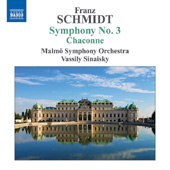
ESSENTIAL RECORDINGS

If the general consensus indicates that Franz Schmidt's Fourth Symphony is a masterpiece, than this, his Symphony No. 3 in A major
must have been a test run for it. Written only 5 years earlier, it displays the same attention to detail, the same long harmonic line, the same craftmanship, and the same
descriptive narrative without resorting to bombast or histrionics. Despite a few lapses in imagination during the final movement, I would rate this one on par with the
famous Fourth. It was finished in 1928 and premiered by the Vienna Philharmonic, winning first prize from the Columbia Gramophone Company of New York for the best
symphony in the spirit of Schubert's 'Unfinished', as part of the centenary celebrations of Schubert's birth. Although it has nothing in common with Schubert. It stems more
from the influences of Brahms and Bruckner for form, and a touch of Richard Strauss for harmonic intervals and orchestration.
The first movement is definitely the work of a creative mind with a strong imagination. The lyrical main theme is constantly on the move, constantly being tossed around
from instrument to instrument, always being rejuvenated in the process. The music is so well manipulated that even though there is a certain amount of repetition, it
always seems to be re-inventing itself and always sounds fresh. The Adagio movement puts Schmidt's harmonic writing talents well in evidence. Throughout
the whole beautiful movement, and within almost each and every chord, Schmidt inserts a foreign note, a dissonance, that stretches the harmonic language and points
toward modernism. Something that Schmidt always avoided. And again it is so well crafted, so well manipulated, that if you were to remove those dissonances, the music
would lose its charm. Plus all that harmonic tension makes the clean, pure, final chord sound all the more blissful. The Scherzo movement on the other hand
is always upbeat and, along with the opening movement, lends the whole symphony its sunny nature.
This is a neglected symphony that has not been recorded often, so now is your chance to add this gem to your collection. The Naxos recording is open
and clear, and the Malmö Symphony Orchestra's playing, under the clear direction of Vassily Sinaisky, is just as good as the music
itself. A definite number one choice for those who like the music within the 1850 to 1950 time period.
Jean-Yves Duperron - July 2010